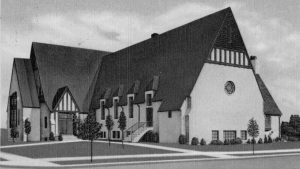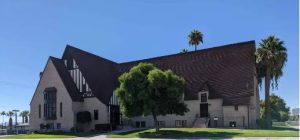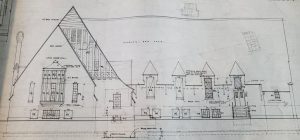Building Also Known As: Las Vegas Chapel & Rec Hall
A&E Related Architect: Ashton & Evans
A&E Work Approx Date: 1932
Architects Confirmed? Utah firm bids (1931).
Original Cost: $46,560 (Nevada chapel)
Builder: Ashton Improvement Company (Utah firm bids)
Site Survival? Y (1995)
Site Condition? Excellent (1995)
Description
The Las Vegas Latter-day Saint ward house was built during the depression and dealt with serious financial issues from beginning to end. When the ward authorities announced that after much prayer and soul searching, a new chapel would be built at 9th and Clark streets, there was strong dissent. “What: Build the chapel way out there in the mesquites and salt grass?” Some members felt that a delegation should go to Salt Lake City and persuade the leaders of the folly of the location. Others hinted at a movement to remove the local church authorities. But the decision held (Earl). Today the building is just a few blocks from Las Vegas Boulevard and is in the heart of town!
An English rural church design was envisioned from the beginning. A rendering was published in the Las Vegas Evening Review Journal in Dec 1931 ($35,000 L.D.S. church) and the blueprints are dated 1932 (Special collections). The Tudor Revival design includes an asymmetrical façade, exposed framing, and a well-known stained-glass window in the chapel.
The building was originally estimated to cost $35,000 and would be funded by three sources: 1) local contributions; 2) matching funds from Latter-day Saint headquarters; and 3) proceeds from the sale of the current ward house ($35,000 L.D.S. church). As a result of the depression, bidding construction firms were instructed to use available Las Vegas craft labor.
Ten bids were opened in Dec 1931, the lowest being Ashton Improvement Company at $42,000. Ashton Improvement Company was owned by Ray Ashton’s uncle in Salt Lake City. Plans were immediately made to vet the out-of-town construction company and to lower the cost to $40,000 (Utah firm bids).
By Mar 1932, a Las Vegas delegation visited Salt Lake City to work out the funding details and convince church leaders of the need for so large a structure. At that point, the Las Vegas ward still had to raise $14,000. None-the-less, they were authorized to begin construction with a planned dedication in Sep 1932 (L.D.S. church to be started). They must have stayed on track, since in Sep 1932, a letter was sent to Edmund P. Evans (the plumbing contractor and Raymond Evans’ brother): “today we were authorized to finish the building and do it P.D.Q. … Will you please catch the first flier out to this town. If you don’t hurry, we shall soon be real desert rats… There will be no more delays” (Ashton). The building was completed in Oct 1932 and was immediately put into use (Earl).
In Latter-day Saint practice, a building isn’t dedicated until the debt is paid. And in this case, the building was not dedicated until Dec 1935 at a final cost of $46,560 (Nevada chapel).
The construction files of the structure show heart-breaking financial issues at every corner between the completion of the building and the dedication (Ashton). For example, to save money the cement floor was laid directly on the alkali dirt. However, not long after the floor cracked and needed to be broken up with jack hammers. The cement chunks and six inches of dirt floor were then manually thrown out of high basement windows. Then six inches of washed gravel and tar paper was brought in onto which the cement was repoured (Earl).
Research Notes
I had access to the 1932 – 33 Las Vegas ward construction records at the Latter-day Saint history library in Salt Lake City. The 28 packed folders were a treasure trove of very detailed correspondence, invoices, receipts, legal documents, and miscellany. The financial burdens of the Las Vegas saints were obvious! My favorite finding was the many copies of “verbal orders don’t go” forms required by Ashton & Evans to document scope changes (Ashton).
My mother (Raymond Evans’ daughter) visited the church in 1995 and wrote: “I was entranced with the building which may be why I took so many pictures.”
After all my research, two questions remain: why did Ashton & Evans bid for a Nevada commission; and why was an English rural church design chosen in the middle of the Nevada desert?
Sources
- $35,000 L.D.S. church will be built. (1931, Dec 16). Las Vegas Evening Review Journal.
- Ashton, George Savage, 1870-1949. Las Vegas Ward meetinghouse construction file, 1932-1933. - https://catalog.churchofjesuschrist.org/record/99a61ef7-f8fc-4c02-ac0a-14bcb3943b06/0?view=summary&lang=eng
- Earl, Marion B. (1977). The history of the Las Vegas First Ward [Las Vegas, Nev.]: The Compiler?. - https://catalog.churchofjesuschrist.org/assets/86d13296-c82c-4e48-bb4f-6a769b112ec2/0/6?lang=eng
- Las Vegas ward building. Willhiteweb.com. - https://willhiteweb.com/lds_historic_sights/las_vegas_ward_building/chapel_132.htm
- L.D.S. church to be started here next week. (1932, Feb 24). Las Vegas Evening Review Journal.
- Nevada chapel is dedicated. (1935, Dec 9). Salt Lake Telegram. - https://newspapers.lib.utah.edu/ark:/87278/s6cg0z8x/16461221
- Physical Facilities Department photograph collection, circa 1890-1988; L; Las Vegas 1st, 9th, and 27th Wards, Las Vegas Nevada Stake; Las Vegas 1st, 9th, and 27th Wards, Las Vegas Nevada Stake; Church History Library, - https://catalog.churchofjesuschrist.org/assets/cc08de54-d0d3-41d3-9087-9cf7fce434c0/0/0.
- Special Collections, Ashton & Evans collection [unprocessed blueprints, Marriott tube 440]. J. Willard Marriott Library, The University of Utah.
- Talbot, B. (2019, Jul 14). Las Vegas (NV) Ward: Interior. Historic LDS Architecture.
- Utah firm bids on Vegas church. (1931, Dec 30). Reno Gazette-Journal.







